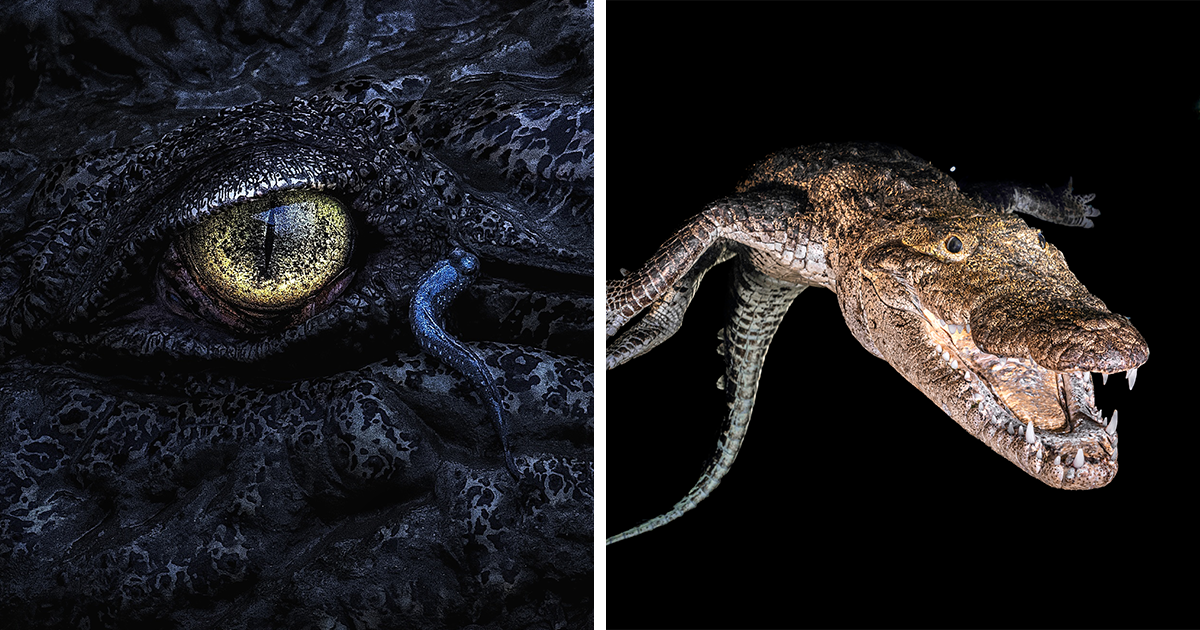
40 Award-winning Images That Stole The Show At The 2025 Mangrove Photography Awards
Mangroves aren’t just tangled trees at the edge of the sea — they are living fortresses, nurseries for wildlife, and lifelines for coastal communities around the globe. And every year, the Mangrove Photography Awards remind us just how awe-inspiring and vital these ecosystems truly are.
Now in its 10th year, the 2025 edition of the awards brought in over 3,300 entries from 78 countries, capturing mangrove forests in all their raw, vibrant, and threatened beauty. Organized by the Mangrove Action Project, the competition invites photographers, from seasoned professionals to passionate amateurs, to explore the rich biodiversity, human connection, and growing environmental challenges faced by these fragile habitats.
From bioluminescent fireflies in Vietnam to crocodiles beneath the stars in the Everglades, the winning images are not just stunning, they tell urgent stories. They speak of survival and struggle, of species that depend on the twisted roots of mangroves, and of people who rely on their shelter and sustenance. They also shine a light on the threats of deforestation, pollution, and rising seas that endanger these crucial ecosystems. Below, we’ve highlighted some of the most breathtaking photographs from this year’s winners, each one a powerful visual reminder of why mangroves matter, now more than ever.
More info: mangroveactionproject.org | Instagram | x.com | Facebook | youtube.com
#1 Overall Winner: Birds’ Eye View Of The Hunt By Mark Ian Cook
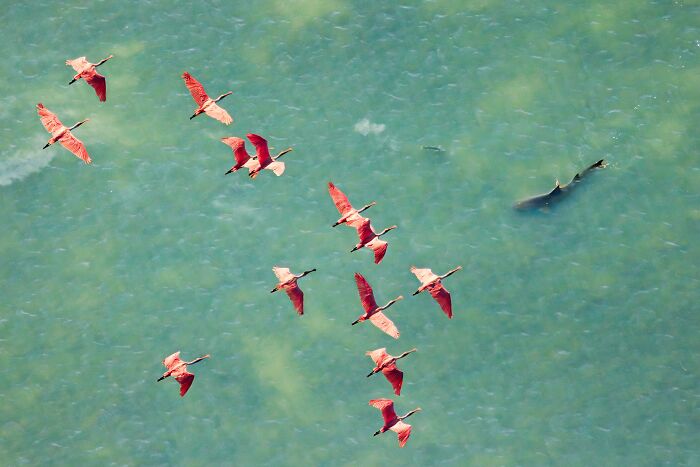
Image source: mangroveactionproject
A flock of Roseate Spoonbills glide over a lemon shark hunting mullet in the shallow, mangrove-lined waters of Florida Bay.
“Historically, Florida Bay was the primary nestling region of the Roseate Spoonbill in the US, but this species is becoming increasingly rare there as sea level rise negatively impacts their important mangrove foraging habitat. This species feeds on small, estuarine fish, which it captures with its odd, spoon-shaped bill. Spoonbills are tactile foragers, meaning they feed by touch. As they forage, they sweep their bill from side to side in the water, holding it slightly open so it creates a negative pressure that effectively sucks any small fish it encounters into the bill. However, for this foraging method to be successful, the birds need relatively shallow water with very high densities of fish. This becomes particularly critical during the energetic bottleneck of the nesting season when the birds need to feed not only themselves but also 2 or 3 rapidly growing nestlings. High densities of fish are produced in the dry season when water levels decline, the area coverage of water in the mangroves shrinks, and fish become concentrated in increasingly smaller and shallower pools. Once a threshold depth of about 13 cm is reached, the spoonbills can feed effectively and start nesting. However, with climate-change induced sea-level rise, these critical lower water depths in the mangroves are increasingly failing to be met, fish densities are insufficient for effective foraging, and fewer birds are able to breed.”
#2 Underwater, Highly Commended: Sunset Snack By Valentina Cucchiara

Image source: mangroveactionproject
A gentle manatee grazes peacefully underwater, nestled beneath the tangled roots of a mangrove forest.
#3 Wildlife, Other Species, Runner-Up: Claws Of Power By Javier Aznar González De Rueda
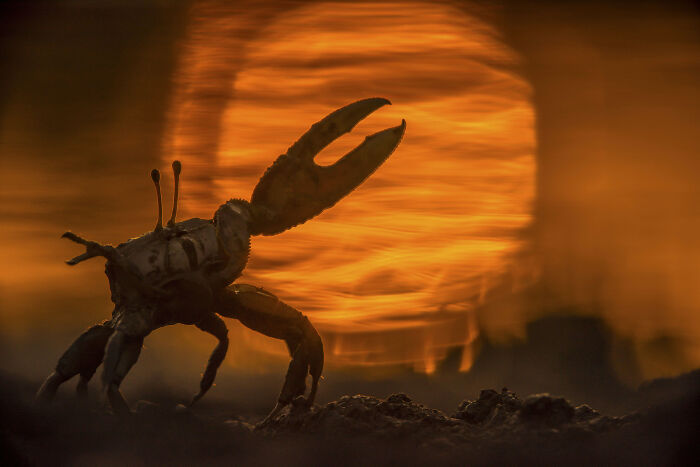
Image source: mangroveactionproject
A male Fiddler Crab (Uca sp.) performing a signal dance in the mud at sunset.
“A male Fiddler Crab (Uca sp.) performing a signal dance in the mud at sunset. During courtship, males wave their enlarged claw and produce sounds to attract females. This behavior is more intense at night and can involve synchronous waving with other males.”
#4 Underwater, Highly Commended: Guardian Of The Underworld By Rodolphe Guignard
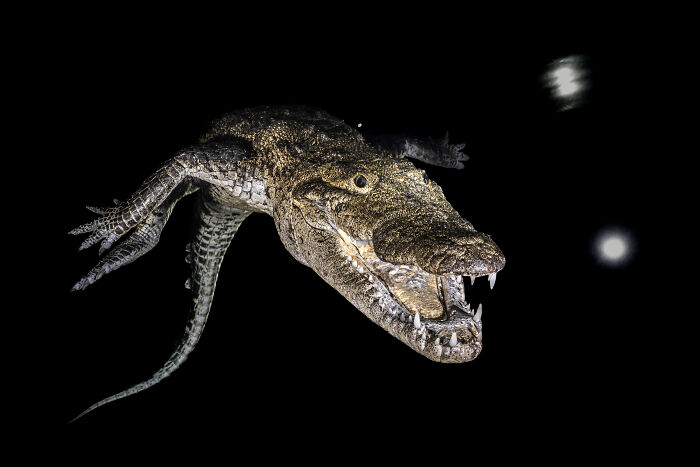
Image source: mangroveactionproject
In Mayan culture, the crocodile is a sacred creature. It links earth, air and water. It is linked not only to nature, but also to the underworld, the place where souls wander. For the Mayans of Yucatan, cenotes are doorways to the underworld. And in mythology, the crocodile floated on the edge between the world of the living and that of the dead. This image of the crocodile, floating on the surface of this cenote, perfectly illustrates this sacred legend.
#5 Wildlife, Other Species, Highly Commended: The Watcher And The Wanderer By Ramprasad Dutta
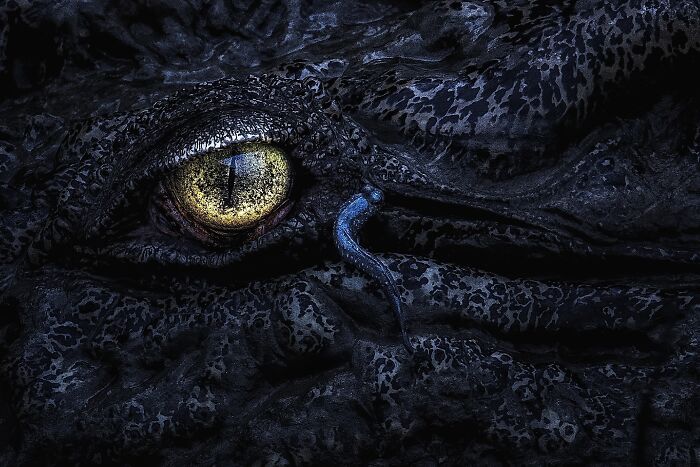
Image source: mangroveactionproject
When giants and minnows coexist.
“In the Sundarbans, a massive crocodile rests near a tiny mudskipper. Despite the size difference, the fish shows no fear. Their contrasting colors create a rare, captivating moment in the wild.”
#6 Wildlife, Mammals, Highly Commended: Mother’s Protection By Satyaki Naha
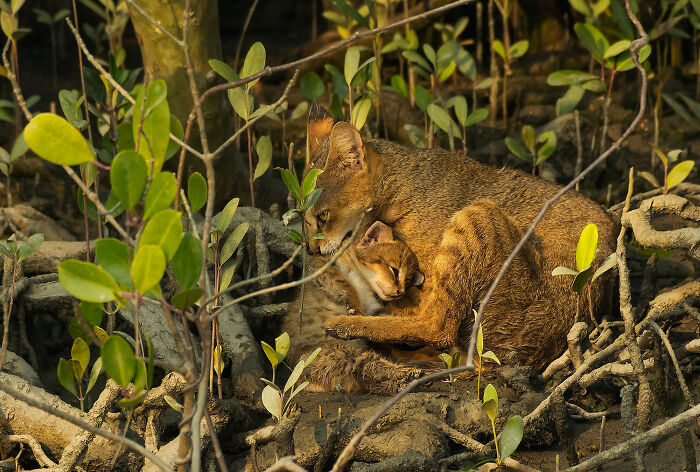
Image source: mangroveactionproject
Mother” is a word that needs no separate definition. The word “mother” is formed with the pronunciation “m”, which is present in all languages, like Maa/Amma, etc. Even in the sound of various animals calling their mother, the influence of “M” can be seen. Nature’s own part is this “Mother” race. So perhaps such is the similarity of these words. In this picture, two mothers are holding their hands and protecting their child. Mother Nature and the jungle cat mother. “One evening in the winter of Indian Sundarban I was in the safari and I had information of jungle cat and her cubs. I was waiting for 3 hours at a distance. After some time, I saw the mother jungle cat sleeping, and her little cub was also sleeping in her lap. At sundown, she started licking her cub, took it up, and moved to the jungle. The whole moment was breathtaking to me. As I saw the lifetime moment, also the protective nature of mother.”
#7 Wildlife, Other Species, Highly Commended: Crocodile Galaxy By Nicholas Hess
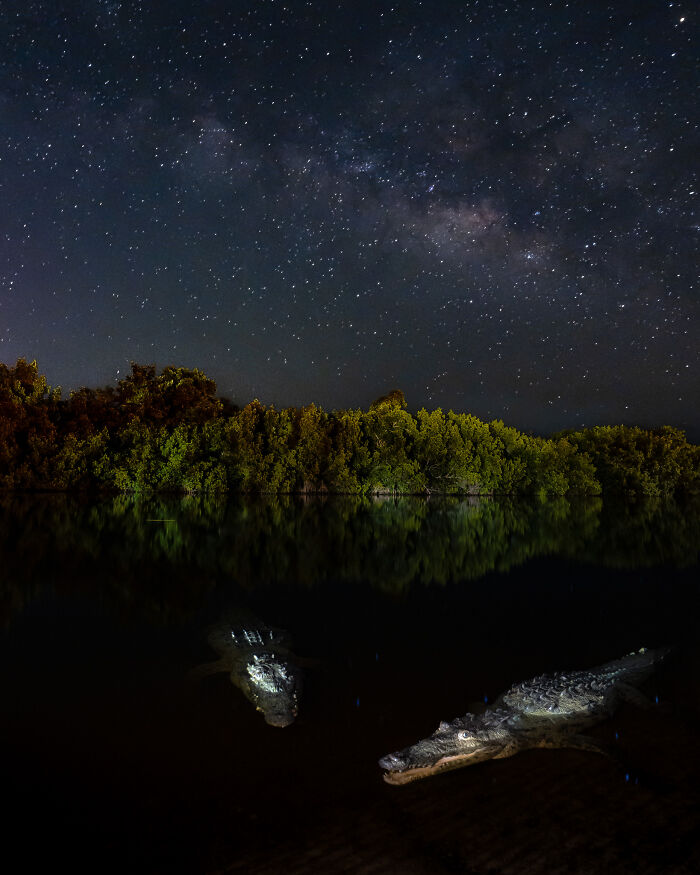
Image source: mangroveactionproject
A pair of American Crocodiles sit before the Milky Way Galaxy in a mangrove forest in the Florida Everglades. “This image is one I’ve hoped to capture for the past 4 years living in Florida. Never whilst visiting this site did I get the chance before. But this day the stars literally aligned. At 2 AM, the Milky Way rose behind not one, but two crocodiles conducting some courting behavior. Seeing my opportunity I set up my tripod to utilize a long exposure to capture the Milky Way in my image. I then used a flash to freeze the crocodile’s subtle movement. After perfecting my settings, I shot a few images as the female appeared to circle the male and below. This one turned out to be my favorite.”
#8 Conservation And Restoration, Highly Commended: Cleaning Up The Coast By Gerdie Hutomo
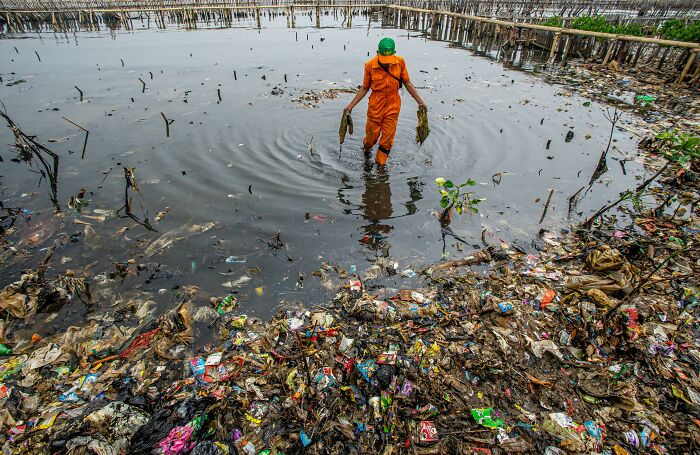
Image source: mangroveactionproject
In Jakarta, Indonesia, a huge amount of rubbish, particularly plastic waste, is ending up in mangrove areas.
“A worker is cleaning the never ending rubbish in a mangrove restoration plot.”
#9 Wildlife, Mammals, Highly Commended: Flower Of Mangrove By Kaushik Ghosh
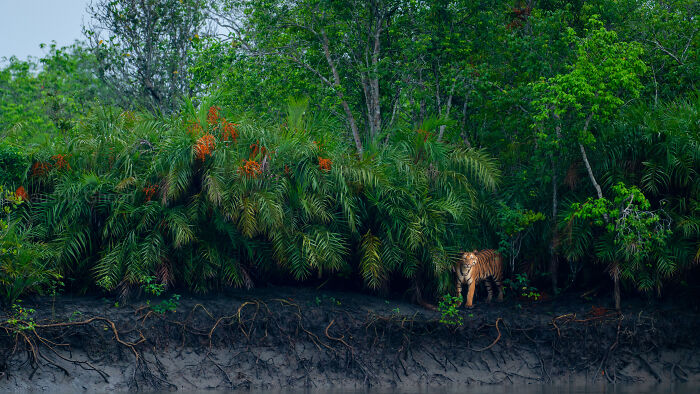
Image source: mangroveactionproject
After hours of tracking through the mangroves, the elusive tiger finally revealed itself in the afternoon — emerging beneath the Hental tree, like a blossom unfolding in the wild. A perfect harmony of predator and habitat. “We had been moving through the dense mangroves since morning, every sound and broken twig fueling our anticipation. Hours passed, the forest holding tight to its secrets — until, in the quiet stillness of the afternoon, it happened. From behind a curtain of roots and shadows, the tiger appeared. She stepped into the light beneath a Hental tree, her presence sudden yet graceful, like a blossom blooming in the wild. In that moment, predator and habitat merged into a single, breathtaking scene — nature, perfectly in balance.”
#10 From The Air, Highly Commended: Guardians Of The Shoreline By Jeff Thamert
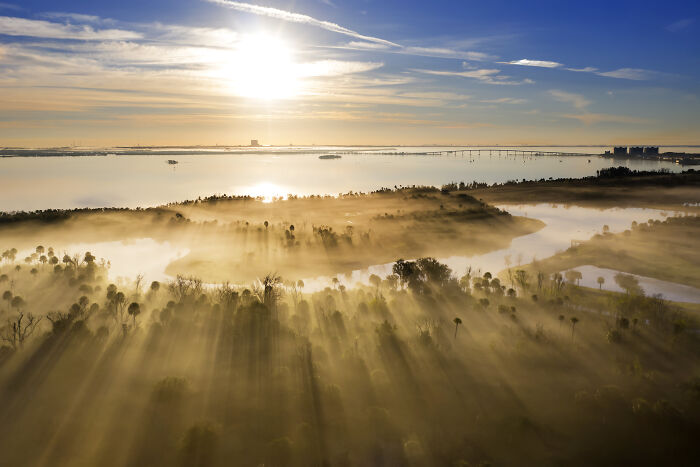
Image source: mangroveactionproject
Mangroves in the mist.
“As Dawn breaks over Florida’s east coast, golden rays pierce the early morning mist, revealing the intricate beauty of the Indian River Lagoon below. Captured by drone, this aerial view showcases a delicate estuarine ecosystem protected by winding shorelines of resilient mangrove trees-nature’s guardians that shelter a vast diversity of wildlife, In the distance, the Kennedy Space Center reminds us that just beyond this peaceful refuge, humanity reaches for the stars. This image celebrates the harmony between natural wonder and scientific ambition, both grounded in the same fragile world.”
#11 Conservation And Restoration, Highly Commended: Protecting The Protectors By Jason Florio
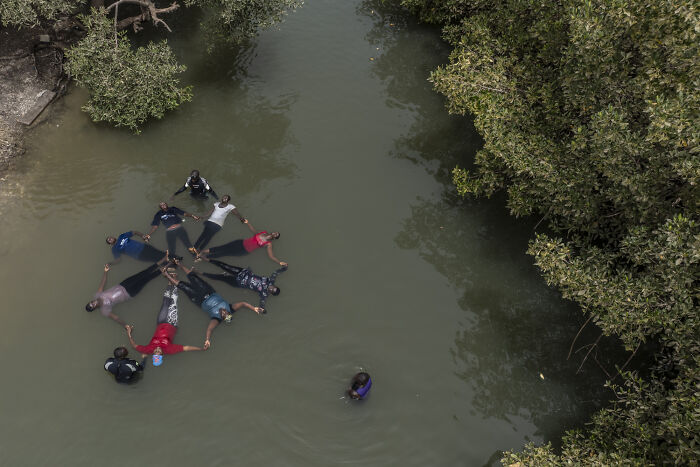
Image source: mangroveactionproject
As part of FAO’s FISH4ACP program, the Gambian Navy teaches oyster harvesters to swim—giving women lifesaving skills and reducing drowning risks in the mangroves. Most had never learned to swim. These women play a vital role in protecting mangroves from illegal deforestation, safeguarding ecosystems that store up to 10 times more carbon than terrestrial forests and are crucial in fighting climate change.
“Gambian Navy swim trainers conducting a session with oyster harvesters. One of the techniques they focus on is just having the women learn how to relax and float in the water. As part of FAO’s FISH4ACP program, the Gambian Navy is teaching oyster women how to swim—empowering them with lifesaving skills and enhancing their safety while harvesting oysters from the mangroves. Most of the women had never learned to swim, and tragically, a number have drowned while working on the river. The oyster women play a vital role in conserving mangroves by preventing illegal deforestation, particularly the cutting of trees by local villagers for firewood. Mangroves are crucial in the fight against climate change, as they can store up to 10 times more carbon than terrestrial forests.”
#12 People Livelihoods, Winner: Bhoben Biseash And His Otters By Freddie Claire
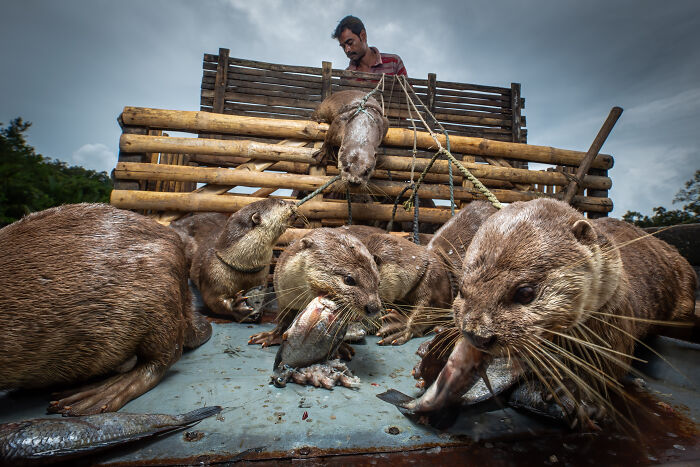
Image source: mangroveactionproject
The otters get their reward for a busy morning of fishing.
“There are only a handful of otter fisherman left and their unusual method of fishing has been handed down from father to son for centuries. The trainer adult otters are tethered and the younger otters swim free. The otters chase fish from the muddy banks into the awaiting nets and after each fishing session get their share of the catch.”
#13 Livelihoods, Highly Commended: Home By Valentin Giebel
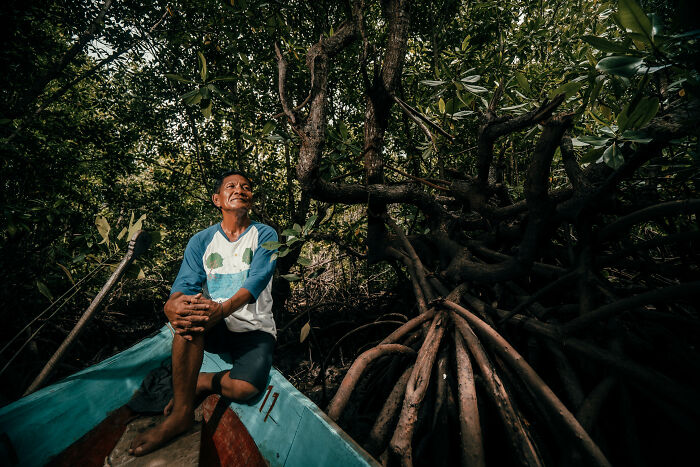
Image source: mangroveactionproject
Pak Umar in the mangroves that protect his home.
“I had the privilege to meet Pak Umar a few months ago. A proud Bajau man who understands the importance of the mangroves for his home and fights for their preservation. The mangroves themselves are an extension of his personality and rich heritage.”
#14 Underwater, Winner: Low Tide On Hermit Crab Island By Alex Pike
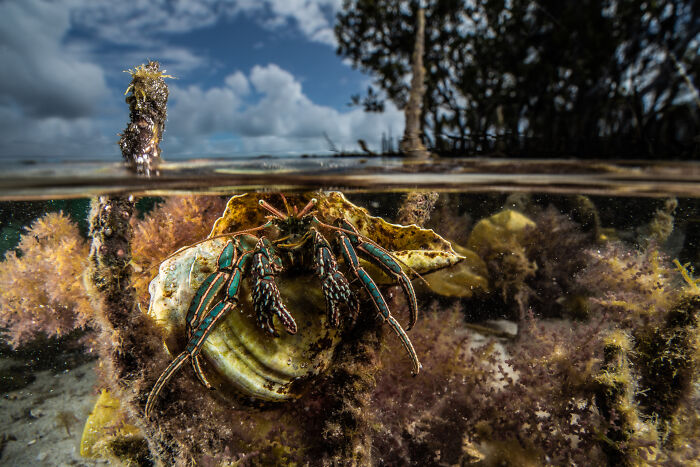
Image source: mangroveactionproject
While Clibanarius taeniatus is one of Australia’s more common hermit crab species, very little is known about it and I’m not sure it even has a common name.
“A study from 2003 found that its presence in large numbers generally indicates an environment that experiences higher freshwater flow than other marine intertidal regions. This is certainly true of the mangrove island I found at the entrance of Lake Macquarie which was absolutely teeming with these creatures. I visited this island at both low and high tides, and at low tide there were literally thousands of C.taeniatus feeding within the matrix of mangrove roots.”
#15 Underwater, Highly Commended: Cuttlefish In The Mangroves By Alex Lindbloom
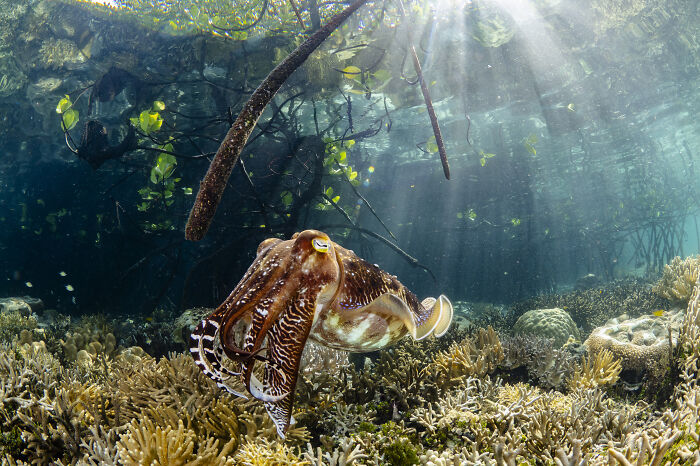
Image source: mangroveactionproject
A large female cuttlefish pauses momentarily before continuing to lay eggs in the shallow reef beneath the mangroves.
“I’ve spent a considerable amount of time snorkeling and diving in the mangroves of Raja Ampat, and one thing I’ve come to learn is that cuttlefish routinely come up to the shallow reefs beneath the mangroves to lay their eggs, quite often in the same piece of coral. This large female had been laying eggs for hours, if not days, and would pause for about five minutes after laying each egg carefully in the corals.”
#16 Young Mangrove Photographer Of The Year, Highly Commended: Mud Serpent By Nitiroj Boonsai

Image source: mangroveactionproject
Dog-faced watersnake (Cerberus schneiderii) finding prey when the tide gets low.
“Dog-faced water snakes are a common species of water snake found in the mangroves of Thailand. They’re venomous but harmless to humans. Their venom is used for hunting small animals.”
#17 Wildlife, Mammals, Runner-Up: Scent Marking Went Wrong By Trikansh Sharma
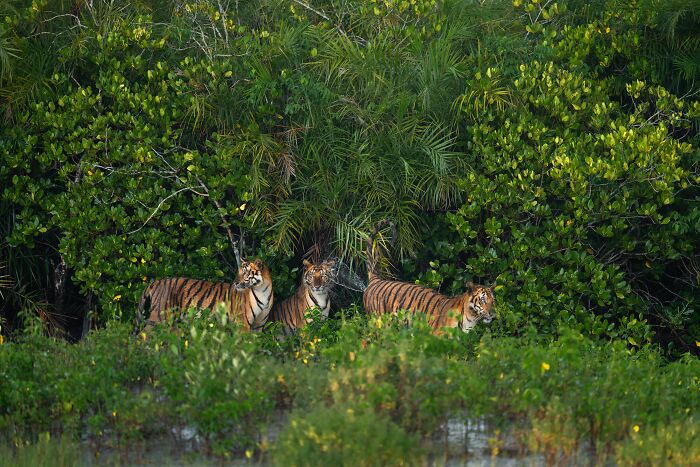
Image source: mangroveactionproject
Sundarbans is a challenging place because Tiger territories keep submerging into water every six hours according to the moon cycle. While there is a myth among people that Tigers do not do scent/territory markings here because they lose the mark in water very quickly, I was lucky to photograph this rare behavior in mangroves. Only funny part was, the entire urine went on the subadult Tiger’s face.
#18 Wildlife, Other Species, Highly Commended: Until The Night Falls By Mark Whiten
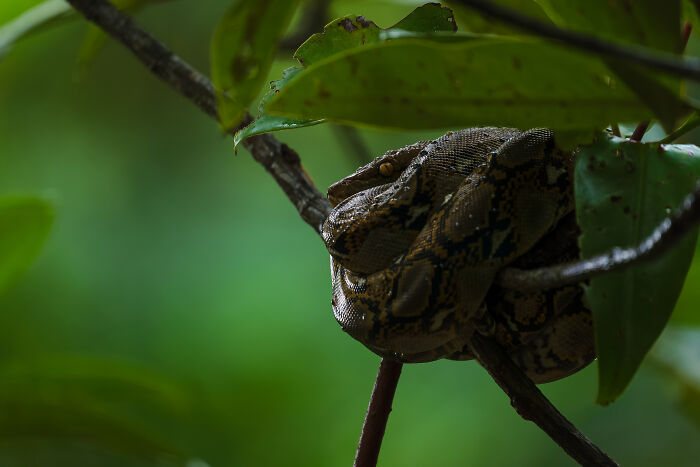
Image source: mangroveactionproject
In the stillness of the Malaysian mangroves, a reticulated python lies motionless in the crook of a tree branch. Hidden in plain sight beneath glossy green leaves, it waits out the heat of the day, conserving energy for the cover of night—when the forest awakens and the hunt begins.
“I was exploring a mangrove forest in Malaysia, scanning the tangled branches and muddy banks for signs of movement, when I spotted this reticulated python coiled on a branch above a narrow stream. It was so well camouflaged against the dappled foliage that I nearly missed it – only the subtle curve of its body gave it away. To avoid disturbing the snake, I kept my distance and carefully set up my tripod on the opposite bank. Using a telephoto lens, I framed the shot to show the python tucked into the crook of the branch, sheltered by the broad leaves above. The dim, filtered light under the canopy made it challenging to expose the scene properly, but it also helped capture the mood of the moment – quiet, still, and almost hidden from view. During the day, mangrove forests can feel eerily calm. Most wildlife lies low, conserving energy in the heat, and this python was no exception. It remained completely motionless the entire time I observed it. Like many reptiles in these ecosystems, it’s likely nocturnal—waiting until dusk to begin its slow, silent hunt.”
#19 Threats, Runner-Up: Trapped In Shadows By Daphne Wong
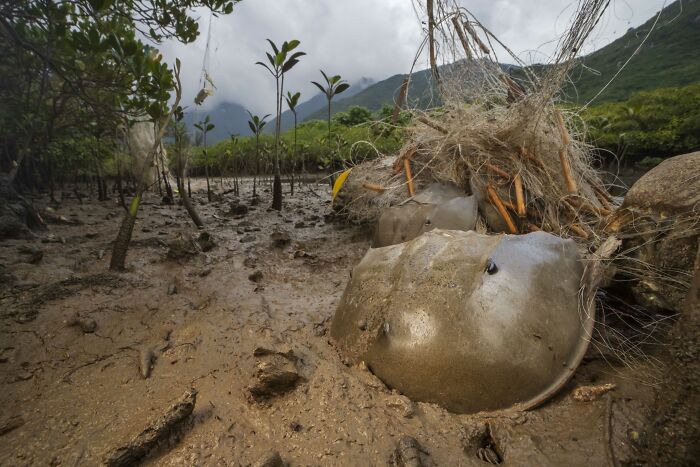
Image source: mangroveactionproject
A poignant reminder of the dangers lurking in our coastal ecosystems: multiple horseshoe crabs find themselves ensnared in a ghost net that became stuck within the mangroves, highlighting the urgent need for action against marine debris, both in the ocean and on our coastlines.
“A poignant reminder of the dangers lurking in our coastal ecosystems: multiple horseshoe crabs find themselves ensnared in a ghost net that became stuck within the mangroves – a very common situation in Hong Kong and throughout Asia. Abandoned fishing nets washed ashore become trapped along the high tide line and in mangrove forests, entangling many creatures, including horseshoe crabs. This can lead to the injury and death of coastal wildlife. This highlights the urgent need for action against marine debris, both in the ocean and on our coastlines.”
#20 Threats, Highly Commended: Prawn Aquaculture By Stuart Chape
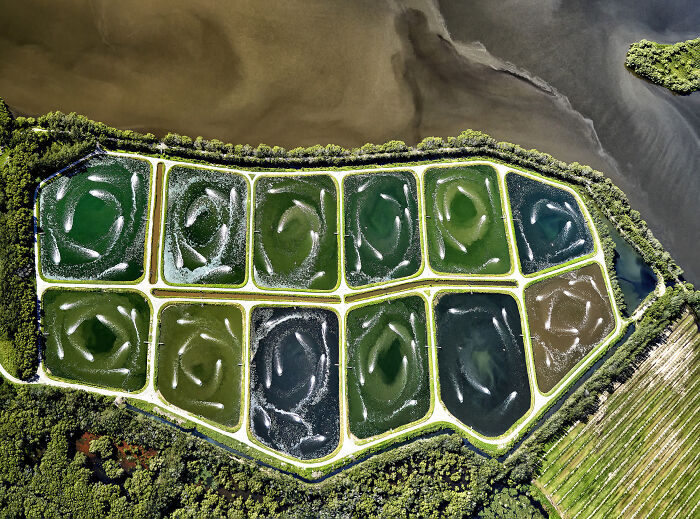
Image source: mangroveactionproject
As in other parts of the world, mangrove ecosystems in Australia are sometimes converted to aquaculture production.
“Part of a series of aerial images taken from a helicopter of coastal ecosystems and impacts in northern NSW.”
#21 Threats, Highly Commended: Cracked Earth By Muhammad Amdad Hossain
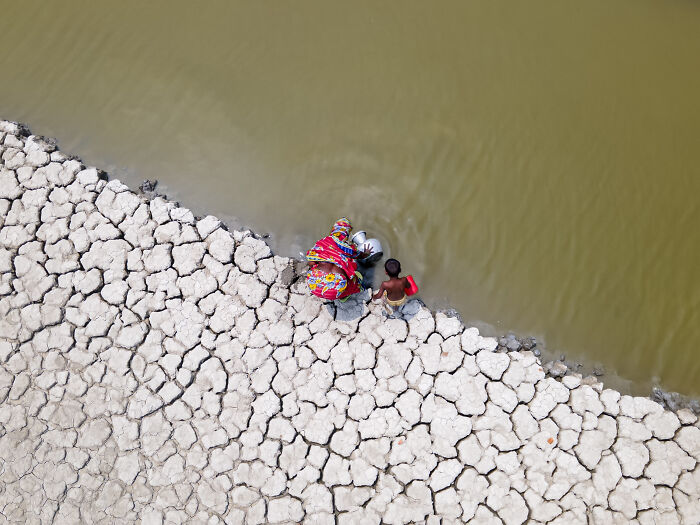
Image source: mangroveactionproject
A determined woman and her grandson collect water from the last remnants of a drought-stricken landscape in Shyamnagar, Khulna. Despite living near a river, they walk 2–3 km daily to find drinkable water due to salinity intrusion, a result of rising sea levels and reduced rainfall affecting the coastal mangrove community.
“On May 15, 2023, in Shyamnagar, Khulna district, this image portrays the harsh reality of water scarcity in Bangladesh’s low-lying coastal belt. A resilient elderly woman and her young grandson are seen collecting precious water from a nearly dried-up source in a landscape ravaged by drought. Although they reside near a river, the water is undrinkable due to severe salinization—an escalating problem caused by rising sea levels and tidal intrusion linked to climate change. Every day, families like theirs are forced to walk 2 to 3 kilometers to access freshwater. The situation worsens in winter months when rainfall is scarce, and even the shallow sources begin to vanish. This scene captures not only their daily struggle but also the broader environmental crisis facing the Sundarbans’ mangrove communities—where once-abundant rivers now carry salt, not life. The photograph stands as a stark reminder of the mounting impact of climate change on vulnerable populations. It reveals a generational fight for survival—where the elderly, the young, and the in-between are bound together by resilience, courage, and necessity. While the mangroves are known for protecting lives from storms and erosion, the people living around them now fight to protect their own lives—one drop at a time.”
#22 Landscape From The Air, Winner: Mangroves And Modernity By Ahmed Badwan

Image source: mangroveactionproject
The harmonious blend of mangrove nature with the modernity of the city — a captivating contrast where urban innovation meets the timeless rhythm of the wild.
#23 From The Air, Runner-Up: Dendritic By Stuart Chape
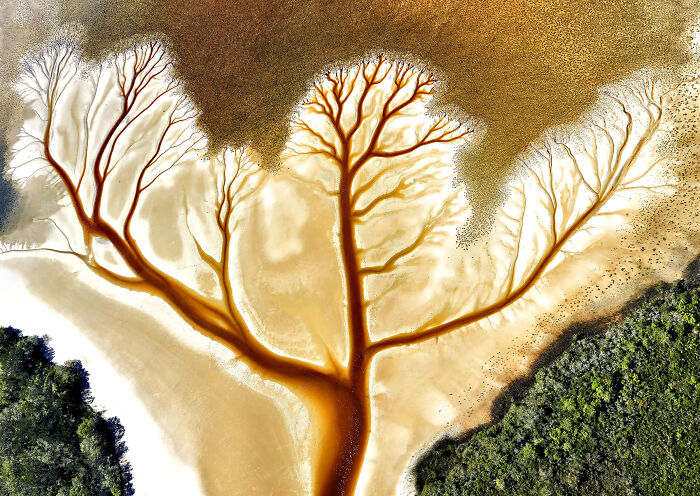
Image source: mangroveactionproject
Aerial image taken from a helicopter of a tannin stained tidal creek and mixed mangrove community, NSW north coast.
“Part of a series of aerial images recording the coastal ecosystems of northern NSW.”
#24 From The Air, Highly Commended: The Floating Village By Max Terwindt
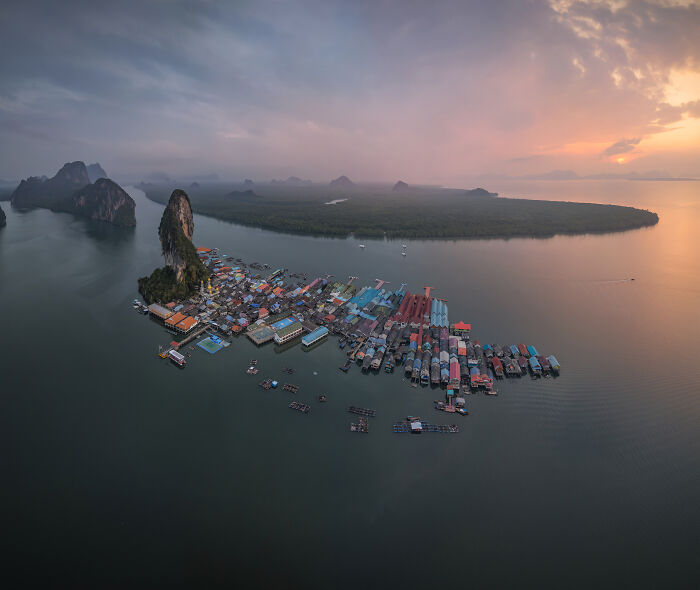
Image source: mangroveactionproject
Aerial image of a Thai floating village in between mangrove landscapes.
#25 Wildlife, Mammals, Winner: A Snack In The Mangrove Forest By Satwika Satria
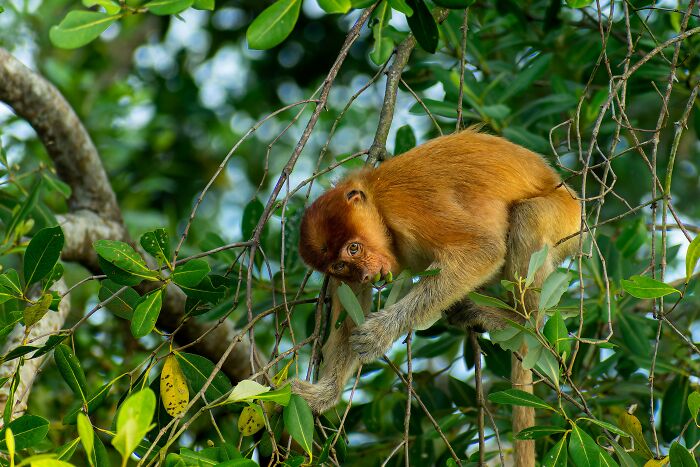
Image source: mangroveactionproject
A young proboscis monkey enjoys an avicennia fruit amidst the dense mangrove forest. “This juvenile proboscis monkey is seen savoring an Avicennia fruit it found. The avicennia fruit is one of the primary food sources for proboscis monkeys. This image highlights the vital role of mangrove ecosystems in supporting the survival of this endangered species.”
#26 People ,conservation And Restoration , Winner: Mangrove Honey Bees Make Land By Ian Rock
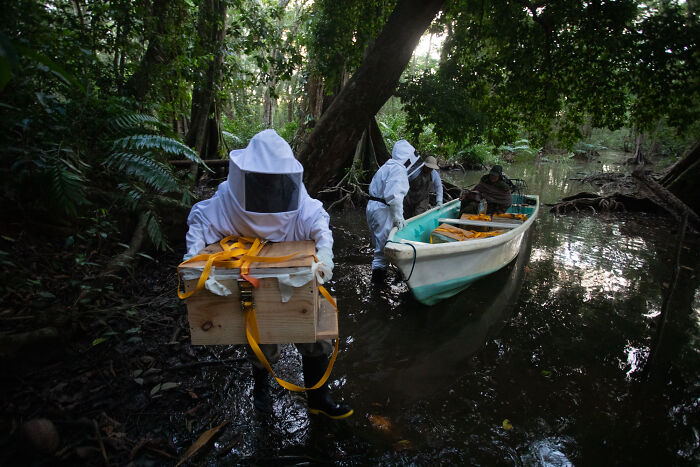
Image source: mangroveactionproject
After a winding route through many narrow canals, fisherman Manuel carries a heavy bee hive off a boat to its new home within the buffer zone of the Terraba-Sierpe mangrove forest, the start of a new mangrove honey project for the community.
“After a winding route through many narrow canals, fisherman Manuel carries a heavy bee hive off a boat to its new home within the buffer zone of the Terraba-Sierpe mangrove forest, the start of a new mangrove honey project for the community. Manuel and the others are local fisherman who live within the the Terraba-Sierpe National Wetland, the largest mangrove forest in Costa Rica. For the local communities that live in this wetland, one of the poorest regions in Costa Rica, their primary source of income comes from fishing. Sadly fish and clam populations are declining from overfishing, loss of habitat, and climate change putting economic pressure on the communities. In order to build resilience for the community, Osa Conservation is working alongside the community to kick start a mangrove honey project, training fishermen like Manuel in beekeeping and business development. Flash to the moment this photo was taken. After months of training it was time to bring the bees to their new home within the buffer zone of the protected wetland. The only access is by boat and very difficult work transporting the heavy hives on unsteady vessels, particularly under the oppressive humid heat of tropical wetlands. Fast forward 6 months and the first batches of honey have been harvested, totaling close to 30kg. Excitement and pride is palpable in the mangrove beekeepers. The community members are working with a Costa Rican branding agency to develop their Mangrove Honey brand. Eventually the honey will be available commercially, first in the local lodges and shops of the Osa Peninsula and then further around Costa Rica. The honey is delicious and unique, with a distinct salty sweet flavor. Ideally in the future, this project has ripple effects, creating even more opportunities for a community with limited options, opportunities that are dependent on a prospering mangrove ecosystem rather than an over-harvested one. A resilient people and a resilient ecosystem. ”
#27 Livelihoods, Runner-Up: Crab Gatherer By Danilo O. Victoriano Jr
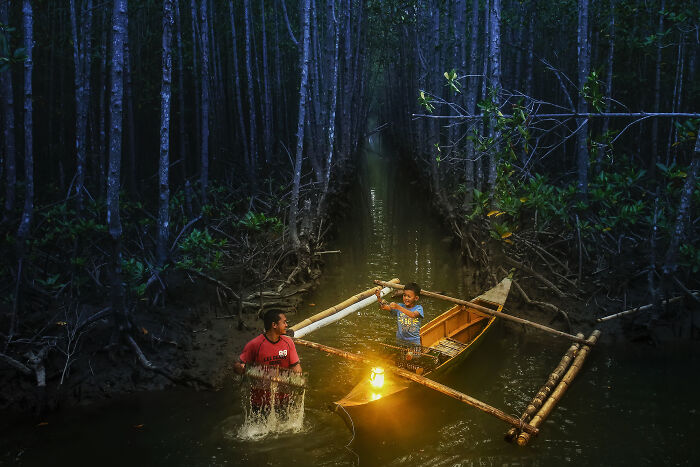
Image source: mangroveactionproject
Bakhawan Eco-Park in Kalibo, Aklan is a powerful story of nature’s revival and community resilience. Once a polluted shoreline, it has transformed into a thriving 220-hectare mangrove forest—protecting against climate threats and sustaining local livelihoods. This award-winning eco-park now stands as a symbol of hope, where families like the father and son in this photo enjoy the bounty of restored ecosystems.
“Bakhawan Eco-Park: Where Nature Heals and Communities Thrive” Once a barren, muddy coastline scarred by pollution, Bakhawan Eco-Park in New Buswang, Kalibo, Aklan now breathes life as a 220-hectare man-made mangrove forest—an inspiring symbol of restoration and resilience. Launched in 1990 through the vision of local government and NGOs, this reforestation initiative was born out of necessity—to shield the town from floods, storm surges, and the looming threat of climate change. Today, it’s more than a forest. It’s a living sanctuary teeming with mangrove species, fish, crabs, and migratory birds—an ecosystem reborn. But its impact stretches beyond the environment. For the local community, Bakhawan has sparked new hope: sustainable crab and fish harvests have revived livelihoods and strengthened food security. In this photo, a father and son share a joyful moment over a basket brimming with freshly caught crabs—a powerful image of nature’s generosity and the legacy we pass on. Celebrated globally, including accolades from the UNFAO and the Golden Eagle Award, Bakhawan Eco-Park is not just a success story—it’s a beacon of what’s possible when people and the planet grow together.”
#28 Livelihoods, Highly Commended: Working On The Curve By Mayukh Ranjan Das
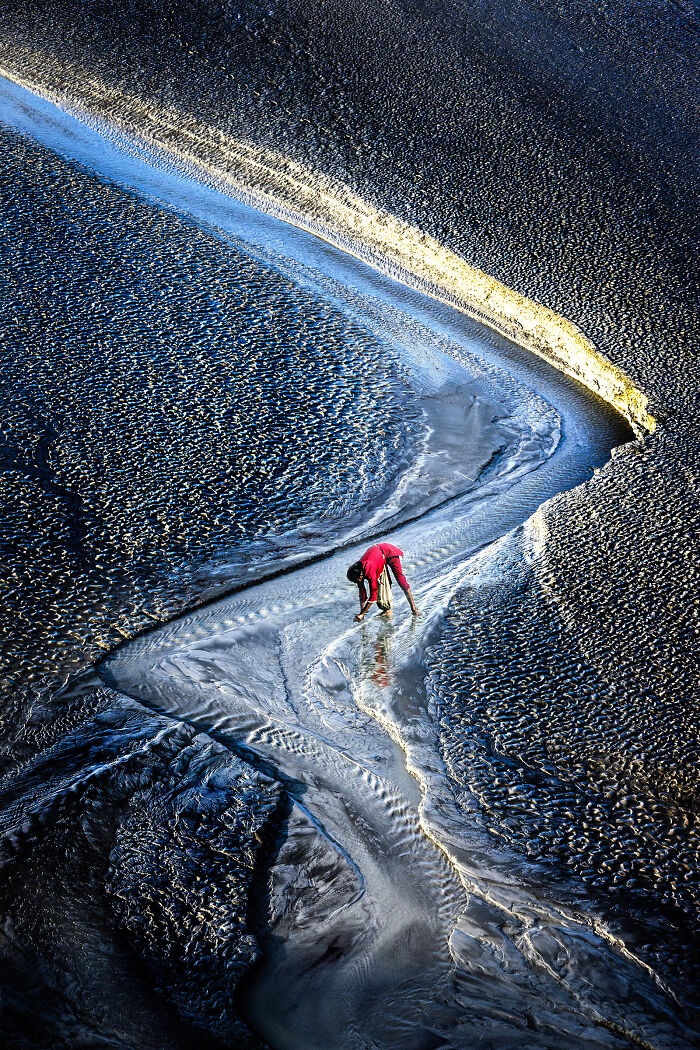
Image source: mangroveactionproject
At low tide along the winding banks of the Matla River in Canning, a village girl bends gracefully over the exposed mudflats, carefully picking oyster shells. Dressed in red, she stands out against the cool, textured earth, her reflection mirrored in the riverbed. The curving riverbed guides her steps like a natural path, each shell a small offering from the receding tide. In this quiet labor, her presence becomes part of the landscape’s raw, rhythmic beauty.
“As the tide ebbs from the serpentine curves of the Matla River in Canning, the riverbed unveils its textured secrets—wet, glistening mudflats etched with ripples, trails, and the soft shimmer of late afternoon sunlight. In the midst of this raw, expansive landscape, a village girl in a red dress bends low to pick oyster shells. With quiet focus, she sifts through the soft mud, fingers expertly picking shells nestled in the ridges left by retreating water. Her presence is both purposeful and poetic—each shell she collects holds value, whether for sustenance, sale, or the rhythm of a daily routine that binds her to the tides. The land around her is alive yet silent, echoing only the distant cry of a heron or the faint rustle of wind in the mangroves beyond. The Matla, with its unpredictable swells and brackish waters, is both friend and threat—a provider of life and a reminder of nature’s unforgiving edge. During low tide, it offers this narrow window of opportunity, when its receding waters allow access to the hidden world beneath. For the girl, this moment is not just about shells but survival, tradition, and a deep, inherited knowledge of the land and river. The curve of the river acts like a natural frame around her, a reminder of how human life here is woven into the pattern of water and mud. All the oyster shells will be sold to make food for the nearby poultry farm. Her feet leave fleeting prints in the silt, washed away with the next tide, yet echoing the countless footsteps of those who came before her. The shell-picking is a ritual of resilience in a landscape shaped by impermanence. This scene, humble in scale, captures the enduring relationship between people and place in the Sundarbans delta. It speaks of dignity in simplicity, of childhood shaped by tides, and of a community’s ability to find life and meaning in the most fluid and challenging of environments.”
#29 Underwater, Runner-Up: Netted Sulawesi Scene By Renee Capozzola
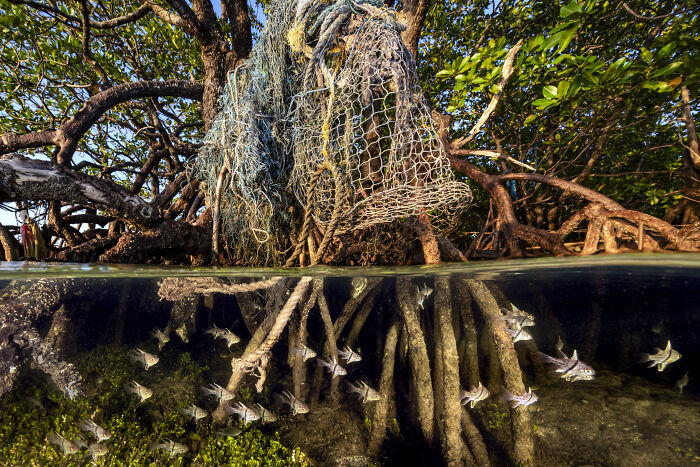
Image source: mangroveactionproject
Half and half scene of mangroves, cardinalfish, and ghost net.
“This half and half image was shot in the shallow mangroves around Bangka Island in North Sulawesi, Indonesia. While exploring the shallow area near the roots, I stopped to take a picture of this discarded fishing net that had washed up into the tree roots and then noticed a few shy cardinalfish peeking out from the roots behind. I waited patiently for more of these cardinalfish to come out from the roots and then was able to capture this scene. Ocean debris such as this ghost net pose a threat to wildlife, including fish and birds which live amongst the mangrove forest.”
#30 Underwater, Highly Commended: Blacktip Reef Shark In The Mangroves By Kiliii Yuyan
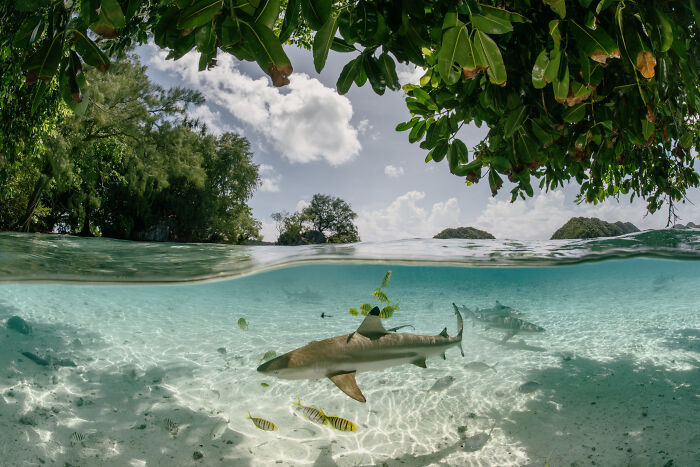
Image source: mangroveactionproject
A juvenile blacktip reef shark swims in its mangrove lagoon nursery in Palau.
“Juvenile blacktip reef sharks cruise in the shallows under the mangroves in a portion of Palau’s Rock Islands Southern Lagoon, a UNESCO world heritage site. At this site known as shark city, tour operators will throw their leftover lunches for the sharks to eat, bringing them close for tourists to enjoy. Sharks are protected in Palau- it was the first nation to declare itself a shark sanctuary.”
#31 Emirates Award, Highly Commended: Mangrove Escape By Ahmed Badwan
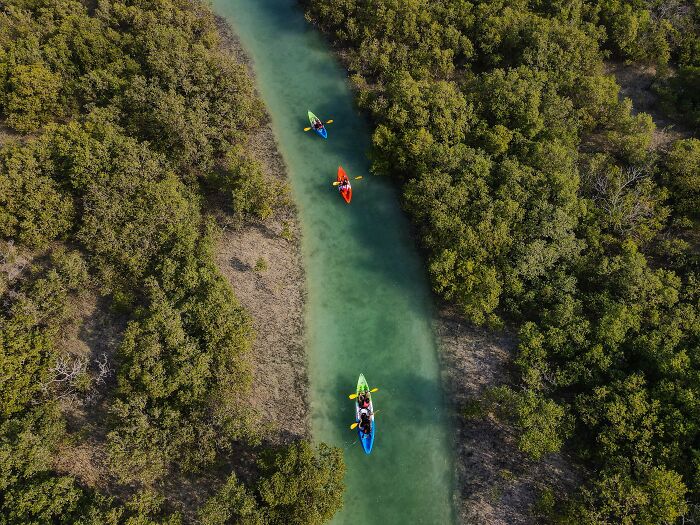
Image source: mangroveactionproject
A leisurely escape through the tranquil mangrove channels of Abu Dhabi — where calm waters, winding paths, and the gentle rustle of leaves create a perfect harmony between adventure and nature.
#32 Wildlife, Birds, Winner: Avian Impressionism By Mark Ian Cook
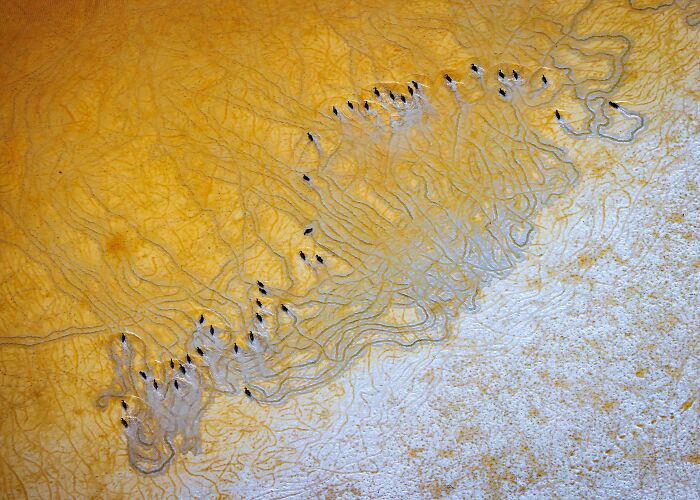
Image source: mangroveactionproject
Blue-winged Teal create ephemeral artwork as they dabble for food in the chai-coloured shallows of Florida Bay, Florida.
“This image was taken last autumn after the summer rains had sent much-needed freshwater flows into the Florida Bay estuary. The odd yellow colour is entirely natural and is a consequence of the mangroves lining the bay; the first flush of freshwater from the Everglades gains this rich whiskey hue as it passes through the swamp and extracts the tannins leached from decaying mangrove leaves. The migrating teal are feeding just downstream of the mangroves, dabbling and filtering high densities of algae and other microorganisms from the shallow edge of the bay. It can be a challenge to produce creative aerial images of the topographically flat Everglades, so it’s often necessary to find subjects that are willing to interact with their habits in strange and wonderful ways, like these artistic teal. Here, my aim was to capture something of the ecology or essence of the ducks while also attempting to fit that into a visually appealing composition that incorporates, to the extent possible, the patterns, textures, and colours of the environment. It’s this combination of animal behavior and a captivating habitat that I believe makes for the most compelling images.”
#33 Wildlife, Birds, Runner-Up: Mangrove Trees: A Safe Haven And Natural Rest Stop For Migratory Birds On Their Seasonal Journey By Ibrahim Alshwamin
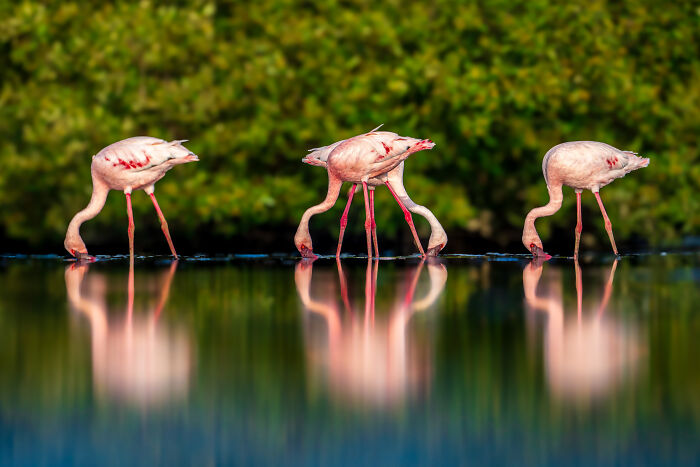
Image source: mangroveactionproject
In the Jazan region, mangrove trees are vital coastal habitats that provide a rich food environment for migratory flamingos. These birds feed on algae and small invertebrates like crustaceans and plankton in the shallow waters. The mangroves offer a safe refuge, shielding them from disturbances and predators—making them an ideal rest stop during migration and a key contributor to biodiversity along Saudi Arabia’s coastlines.
“Mangrove trees in the Jazan region form a crucial habitat supporting migratory birds traveling from Europe to Africa, especially flamingos. This coastal ecosystem is rich in algae, crustaceans, and microscopic plankton—providing ideal nutrition for flamingos, which feed by filtering tiny organisms from the shallow water. Beyond nourishment, the mangrove environment offers a safe refuge from predators and environmental disturbances, making it a strategic stopover during the long migration. The dense roots and calm waters of the mangroves help minimize risks and allow the birds to recover their energy. Jazan is one of the most important stopover sites along the global migration route, attracting a variety of waterbirds in addition to flamingos, such as herons, terns, and spoonbills. Preserving this habitat is essential for supporting biodiversity and maintaining migratory pathways.”
#34 Wildlife, Birds, Highly Commended: Patience By Nicholas Hess
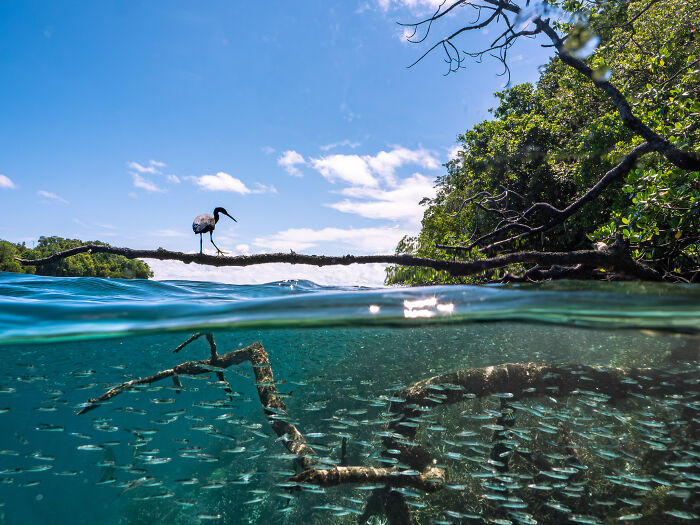
Image source: mangroveactionproject
A Pacific Reef Heron hunts a school of fish from a mangrove branch in Raja Ampat, Indonesia. “This branch was a favorite hunting site of the local reef herons. I observed this individual’s behavior and wanted a shot of both the fish beneath the surface and the bird above. It was challenging to compose with the moving water surface, and the school of fish were quite dynamic. After patience on my part for the fish and bird to line up, and on the part of the bird as it hunted patiently, I managed to capture the image with the school of fish near the front, and the bird in a dynamic moment. I like this image because it so clearly demonstrates the existence of mangroves as the threshold between water and land. Here, the mangrove branch provides a perch for the bird, and protection for the fish.”
#35 Wildlife, Birds, Highly Commended: Pyramid Of Scaup By Mark Ian Cook
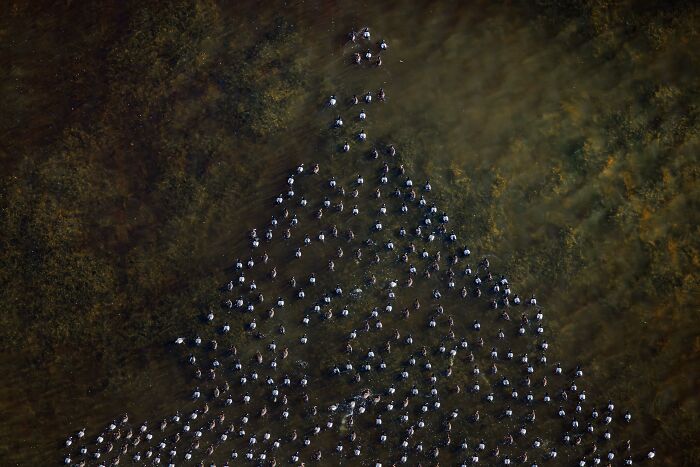
Image source: mangroveactionproject
Part of a massive flock of diving ducks (primarily Lesser Scaup) apexing momentarily into an odd pyramidal shape in one of the mangrove-lined coastal lakes of Everglades National Park. “The coastal lakes of the Everglades are set within a dense matrix of mangroves adjacent to the Florida Bay estuary. Historically, prior to the drainage of the southern Everglades in the 1940s, these lakes were slightly brackish, crystal clear, and supported dense beds of aquatic vegetation, which in turn supported an abundance of animal life, including hundreds of thousands of migrating and wintering waterfowl. As the flows of the water from the north were curtailed by human activities, the salinity of the lakes increased considerably, the aquatic vegetation largely died off, and increased sedimentation and nutrients reduced the clarity of the water and the ability of the vegetation to recover. With the loss of the vegetation and the rich diversity of prey animals it supported, the waterfowl vanished from this part of the world. But with much increased volumes of freshwater flowing south last year because of the El Niño conditions, as well as recent restoration activities that allow more water to flow to this part of the Everglades, the coastal lakes have been recovering and, for the first time in 80 years, have attracted tens of thousands of waterfowl. There’s much still to do to get the water right for the Everglades, but this is yet another very encouraging sign that we’re heading in the right direction.”
#36 Wildlife, Mammals, Highly Commended: The Silent Sentinel Of The Mangroves By Tanmoy Das Karmakar
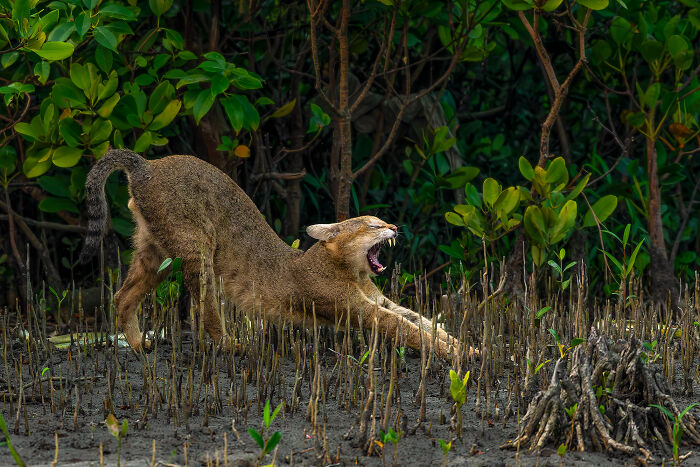
Image source: mangroveactionproject
In the heart of the Sundarbans, the elusive Jungle Cat awakens with a powerful yawn — revealing nature’s sharp edge amid the tangled roots and tidal waters of the mangrove wilderness.
“In 2021, during a boat safari in the Sundarban Biosphere Reserve, our quest for the elusive swamp tiger went unanswered. As we turned back, a sleeping Jungle Cat emerged from the mangrove shadows. I captured its slow awakening — a deep stretch and a powerful yawn exposing sharp teeth — before it vanished into the dense tidal forest. This fleeting moment perfectly reflects the Sundarbans’ mysterious spirit and the wild rewards of patient observation.”
#37 Wildlife, Other Species, Highly Commended: Tidewalker By Vydehi Kadur
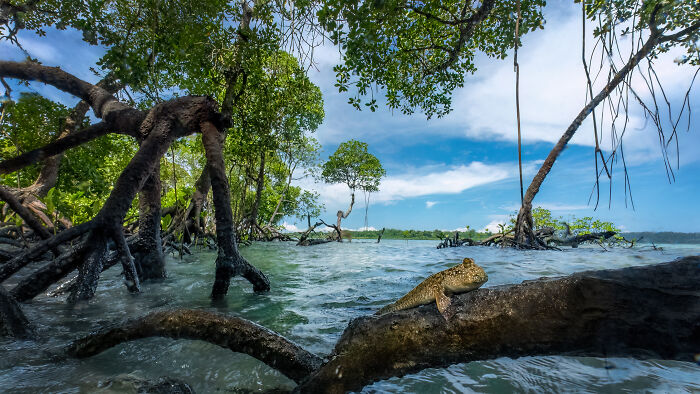
Image source: mangroveactionproject
Amid the tangle of mangrove roots on Havelock Island in the Andaman archipelago, India, a mudskipper (Periophthalmus sp.) rests between the arching roots of a Rhizophora mangrove tree. Perfectly adapted to an amphibious life, mudskippers use their pectoral fins to “walk” on land, while their protruding eyes scan both sky and water for predators. Thriving at the edge of two worlds, these remarkable fish are synonymous with the mangrove ecosystem. “As the tide receded along the mangrove edges of Havelock Island in the Andamans, I found myself immersed in a quiet, unfolding ritual. A group of mudskippers (Periophthalmus sp.) clung to the textured bark of a mangrove root—startled, as always, by the retreating water. They looked stunned and frantic as they scurried back toward their vanishing home, as if the tide might not return. It became essential to capture the movement of the water—not as chaos, but as softness. A long exposure helped me translate that rhythm: the water melting into gentle motion, framing the stillness of the mangrove roots and the anxious little fish. I wanted that softness to contrast the other elements in focus, to reveal the quiet tension in this everyday event. After nearly four hours of sitting perfectly still—no adjustments, no shifts, barely a breath—the mudskippers slowly accepted my presence. While they remained wary, they no longer scattered at every twitch. And that trust, however tentative, allowed me a rare opportunity: to use my 16–35mm wide-angle lens to attempt a close-focus wide-angle shot—an intimate frame in a vast and shifting world. This image is a tribute to patience, to stillness, and to the strange beauty of creatures who live between land and sea, reacting to every tide as if it were the first.”
#38 Wildlife, Other Species, Highly Commended: The Sunset March By Emanuele Biggi
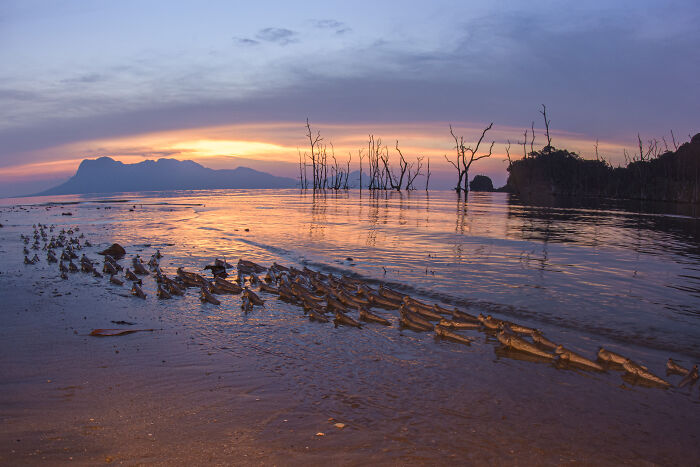
Image source: mangroveactionproject
Mudskippers (Periophthalmus chrysospilos) march and feed together along the shore, following the tide. Kubah National Park, Borneo Island, Sarawak, Malaysia. “To shoot this image along the shore surrounded by mangrove forest in the Bako National Park, I stood still in the mud, along the shoreline, for almost two hours. The sun was setting, and I hoped the mudskippers would eventually get less shy and march in front of my lens. They were marching and feeding all together, and it was something amazing, but if you tried to approach them just by walking, they fled into the water and regrouped elsewhere, far away. So I tried to “become a fallen tree,” and it finally worked out.”
#39 Threats, Highly Commended: Growth Or Proliferation? By Vidyasagar Hariharan

Image source: mangroveactionproject
Lesser flamingos during sunrise in a Navi Mumbai wetland lake with cut mangrove trees and a building’s reflection in the water. “During winter, thousands of lesser and greater Flamingos visit Mumbai and Navi Mumbai and stay on till the monsoon starts. In one of the wetland lakes in Navi Mumbai, mangroves were cut, and this was brought to public attention at large. Here, a group of Flamingos can be seen near a mangrove that has been cut, with the reflection of an adjoining high-rise that looms large. Is it growth or proliferation?”
#40 From The Air, Highly Commended: Veins Of Resilience By Karim Iliya
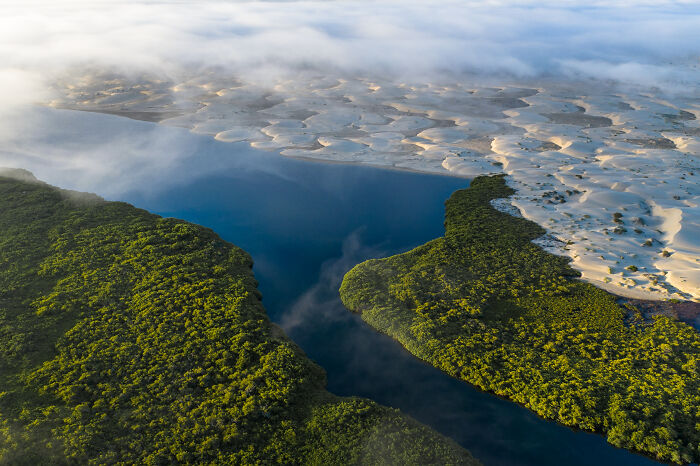
Image source: mangroveactionproject
From above, the mangroves of Magdalena Bay resemble green lifelines threading through the desert—an ecosystem defying expectations.
“Hovering over Magdalena Bay reveals a stark truth: life finds a way. The winding channels of mangroves appear like veins across the arid coastal desert, drawing water and life into a seemingly inhospitable landscape. This bird’s-eye view reminds us how interconnected Earth’s systems are—where moisture meets heat, where the sea bleeds into land. Mangroves here offer refuge to fish, birds, and mammals while withstanding rising tides and human pressure. The beauty and resilience of this ecosystem, etched into the landscape like brushstrokes of life, call for stewardship. This is not just scenery—it’s survival, painted in sand and chlorophyll.”




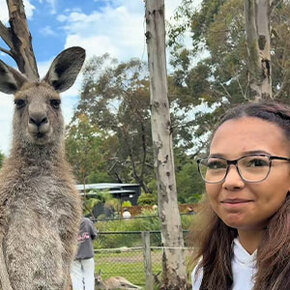








Got wisdom to pour?